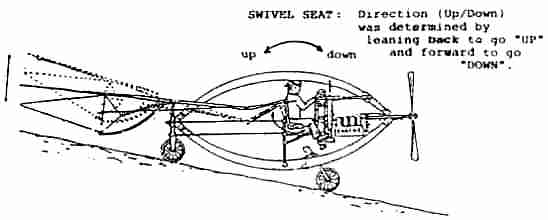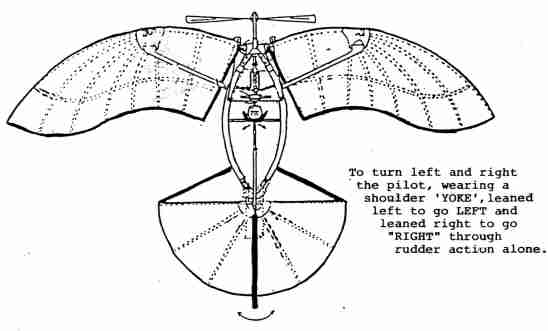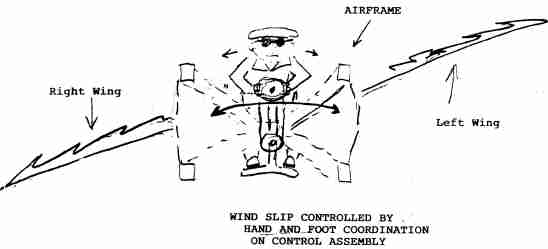|
W. L. QUICK AND THE QUICK MONOPLANE by Major Ronald V. Regan, Sr. 28944-39 Hubbard Street Leesburg, Florida 34748 Email: (ronregan@lsbg.net) In the beginning, man believed flight to be the privilege of mythological Gods... the Gods of Crete, of Egypt, of Assyria, and of Greece. Later, as man's capabilities overcame the mantle of myths, he developed his power to dream... to dream of his own ability to fly. It was not until 1903 that the Wright Brothers, using their mechanical ingenuity, accomplished powered flight on the sands of a North Carolina beach. Even though the Wright Brothers are today given credit for controlled flight.. there were many more aviation inventors who were involved in singular and like ideas for manned flight. Each wanted to be the first to conquer the sky! It was during the late 1890's and early 1900's that Will Quick, a thinking man in rural Alabama, dared to design, build and fly his own single-engined, propeller-driven, bat-shaped, low winged monoplane. It was truly unique and ahead of its time. Other inventors of that era basically used a bi-wing supported aeroplane. In fact, all through World War I, single engined fighter planes on both sides were bi-winged models. Even a few were the famous "Red" Baron Von Richtoffen, in his Fokker - D, three-winged affairs. It wasn't until the 1920's that the monoplane became the technical goal of airplane industry. Will Quick was born in 1859, married in 1882, and fathered ten children. As a businessman, he ran a blacksmith and tool shop, a sawmill, and a grist mill--- all known locally as Quick's Mill. He even invented a new type of field plow... and sold the patent to the McCormick Implement Company. Having only a sixth grade education, he read books and found insects to be intriguing creatures of flight. As an obsessed student of science and nature he diligently studied the dragonfly for his answers to powered flight. Once he had his craft built, he waited many years for an engine to carry him into sustained flight. Had he the knowledge, or the resources like the Wright Brothers to build their own aeroplane engine, Will Quick could have been the first to fly! I feel that Will Quick, because of his aviation accomplishemts, deserves greater technical and public recognition. Every important invention that was ever created during (or since) the "Industrial Revolution" in America has had more than one contender. It is just that history tends to skip over the stepping stones... and gives credit to only the victor. HOW HE ENVISIONED IT ALL.... The fuselage of Will Quick's aeroplane is in a shape resembling a football. A football, however, without a covering and just four spruce spars to shape a crude four-sided framework. All four spars, both forward and aft, were connected at each end with a handformed metal "socket shaped coupling." From within this framework sat the pilot of this strange craft. His job (and it really was a job as you shall see) was to perform many simultaneous and singular manipulations of various control apparatus to control the vertical, horizontal and roll attitude of such an airborne machine. As Figure 1 illustrates, the pilot controlled the vertical climb and descent attitude of the craft by simply tilting the hinged chair. If he leaned back, the craft would go up, and if the pilot leaned forward, the craft would go down. A disasterous, but humorous event took place on the maiden flight of this aeroplane because of this rather "unorthodox" control mechanisn. The story will be told a bit later. FIGURE 1.0 -------- |
 |
|
Figure 2 is an additional attempt to control the horizontal flight attitude of the craft in a left/right
direction. A semi-circle shaped device, attached by rods to the rudder, was placed under the armpits of the pilot. In this manner, the
pilot twisted his upper body to the left or right to operate the rudder assembly. FIGURE 2.0 -------- |
 |
|
In Figure 3 you will see how Will Quick decided his craft would operate like a gliding bird. Ever watch
a seagull soar along a breezy beach? Did you notice that the gull's body and head never twisted, but stayed vertically and horizontally
stabilized to the ground all the while the wings frantically caught and deflected the breezes? Well, Will Quick created a "unique" YOKE
control assembly for that maneuver too! FIGURE 3.0.... |
 |
|
Note that the handle bar and foot bar work in unison because of the two circular devices and a
vertical connector bar arrangement. In addition, a spring type 'shock' absorber supplied the proper vertical force between the upper
and lower circular devices and a flat belt encircled everything to provide the proper tension to hold everything from falling apart. Now for a dash of genius. Will Quick attached the hand/foot device (a YOKE control assembly) to four heavy springs. The two upper springs were attached to the upper circular device and each radiated outward to connect the upper left and right fuselage spar. The two lower springs were attached to each end of the foot bar and radiated left and right to connect with support brackets attached to the underside of each wing. Again Will Quick easily adapted his control design around this observation of flying birds (See Figure 4.0). All the pilot had to do was press down with his feet (stand) on the foot bar to simply change the relative angle (Dihedral) between the wings and the fuselage. This would, he thought, prevent an updraft from taking the craft to a higher altitude. Using the same YOKE control assembly principle, a pilot could individually change the relationship (Dihedral) of each wing in relation to the fuselage. This was done by simultaneously exerting a downward hand and foot pressure on the right, or the left. This maneuver was designed to prevent a roll attitude and keep the craft's pilot in constant vertical and horizontal reference to the ground.... like the seagull. FIGURE 4.0... |
 |
|
Well, you can see the pilot was going to be awfully busy keeping this craft in flight. But you AIN'T
seen nothin' yet! In addition, (See Figure 5.0) the pilot could slow the craft by changing the angle of attack of the wing in relation to the
air stream. All he had to do was "YANK" back on a cable that was attached at each end to the left and right forward (leading edge) of
the wing. The wing then tilted upward, like an umbrella, catching the air on a breezy day. That caused the craft to slow down during
the landing maneuver. WHEW! FIGURE 5.0... |
 |
|
Remember I related, a few paragraphs ago, that a disasterous, yet humorous incident took place on
its maiden flight? Well, the real reason Will Quick didn't fly prior to the Wright Brother's feat was due to his inability to find a gasoline
engine powerful enough to provide a fast enough speed to get him and his craft airborne! Years later, sometime in (circa) 1905, he did find what he thought was just the right engine. But it still would not allow the combined weights of Will Quick and the aeroplane to lift off the ground. Will Quick then mustered the aid of his inquisitive 16 year old son. The boy freely volunteered his services because he was obviously light enough in weight to do the job. So Will gave the lad a few hours of ground school on how he could, and should, fly the new aeroplane. The youth obeyed his father. He started the engine, taxied along the ground and slowly gained speed. Then in a flash the boy and craft broke the "surley bonds of earth....." Ten, twenty or more feet it rose. It wa now above the trees! It was then that Will Quick's young son (Will Jr.) in his moment of triumph and elation, leaned forward in his hinged chair and looked down at the earth passing beneath his feet. (CRUUUUUNCH!) Alas! it was a humble, short lived, and somewhat embarassing maiden flight for the WILL QUICK MONOPLANE. However, after a few minor repairs and a bigger engine, Will Quick was seen many times flying above the trees and cotton fields of Madison County, Alabama. Only - 37 - years ago, in 1964, the Quick monoplane was discovered in one of Will's old work barns. It was disassembled, tattered and torn, but all the pieces were there. After some eight years, the craft was painstakingly restored to a like new condition and flown by a commercial jet pilot for a distance of 105 miles to Huntsville, Alabama... and is now proudly suspended above the floor in the Space and Rocket Museum at Huntsville, Alabama. You know... if it weren't for people like Will Quick (those who possessed a keen mind, diligently experimented, and pushed the frontier of aviation technology til sucess was theirs..)..... WE, THE PRESENT MEMBERS OF THE CIVIL AIR PATROL WOULD NEVER BE IN BUSINESS...... |


|